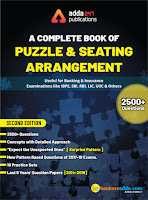IBPS RRB PO/Clerk Reasoning Quiz
The reasoning is an important part of a banking examination that holds the key for scoring well. This section tests the logic of a person while solving the questions. A good score depends on the clarity of your logical ability to crack the pattern of the question. This can only be attained if you practice daily without fail. For the IBPS RRB Mains 2019 Study Plan and also for the upcoming banking examinations including SBI Clerk, LIC ADO, IBPS PO, IBPS Clerk and all the others which are not yet officially announced like the RBI Grade B and the RBI Assistant 2019.
Here is IBPS RRB PO/Clerk Mains Reasoning quiz for 21st of August 2019 and it includes questions from Linear puzzle, Input-Output, Miscellaneous.
Directions (1-5): Study the information carefully and answer the questions given below.
Ten persons are sitting in a row facing either north or south. Each of them likes different colours i.e. Yellow, Green, Pink, Blue, Orange, Red, White, Black, Purple and Brown but not necessary in same order. Not more than two consecutive persons face same direction to each other.
Four persons sit between E and Q. Neither E nor Q sit at extreme ends of the row. E and Q face opposite direction to each other. C who likes red colour sits one of the extreme end of row. The person who likes Brown colour sits immediate right of D. Three persons sit between the one who likes brown colour and R who likes purple colour. Not more than one person sits left of E. S sits second to the right of E. S is immediate neighbor of the persons who likes yellow and pink colour. The person who likes pink colour is not immediate neighbor of E. The person who likes Green colour sits immediate left of Q. R is not immediate neighbor of Q. The person who likes Green colour sits immediate left of B. T sits immediate left of the one who likes white colour. T does not like yellow colour. Only two persons sit between the one who likes Red colour and the person who likes Orange colour. P and the one who likes Orange colour are immediate left to each other. B does not like Black and white colour. The persons those sit at extreme ends of row face opposite direction to each other. A faces south direction.
Q1. Which of the following color does A like?
(a) Brown
(b) Pink
(c) Red
(d) Blue
(e) None of these
Q2. What is the position of Q with respect to S?
(a) 3rd to the left
(b) 3rd to the right
(c) 4th to the right
(d) 5th to the right
(e) None of these
Q3. Who among the following person sit immediate right of R?
(a) T
(b) The one who likes green colour
(c) The one who likes blue colour
(d) C
(e) None of these
Q4. Four of the following belongs to a group find the one that does not belong to that group?
(a) T
(b) B
(c) D
(d) S
(e) R
Q5.How many persons sit between P and B?
(a) One
(b) Three
(c) Two
(d) More than three
(e) None
Q6. If in the number ‘78945386’ 1 is added to second, fourth, sixth and eighth digit and 1 is subtracted from the first, third, fifth and seventh digits, then how many digits are repeated in the new number thus formed?
(a) 5 and 8
(b) 6 and 9
(c) 4, 7 and 9
(d) 4 and 7
(e) None of these
Q7. Sandy is 20th from the left end of a row and Renu is 12th from the right end of row. If they interchanged their positions then Renu ranks become 14 from right end. Find total number of persons in the row?
(a) 31
(b) 33
(c) 29
(d) 35
(e) None of these
Q8. Which of the following elements should come in a place of ‘?’
XC9 UF36 RI81 ?
(a) OL144
(a) OL144
(b) OL121
(c) NM169
(d) MN81
(e) None of these
Directions (9-10): In each question below is given a statement followed by two assumptions numbered I and II. An assumption is something supposed or taken for granted. You have to consider the statement and the following assumptions and decide which of the assumptions is implicit in the statement.
Give answer-
Q9. Statement: In Bombay, railway trains are indispensable for people in the suburbs to reach their places of work on time.
Assumptions:
I. Railway trains are the only mode of transport available in the suburbs of Bombay.
II. Only railway trains run punctually.
(a) If only assumption I is implicit
II. Only railway trains run punctually.
(a) If only assumption I is implicit
(b) If only assumption II is implicit
(c) If either I or II is implicit
(d) If neither I nor II is implicit
(e) If both I and II are implicit
Q10. Statement: “I would like to study the impact of pay revision on job satisfaction of employees.” — A tells B.
Assumptions:
I. Job satisfaction can be measured.
II. A has necessary competence to undertake such study.
(a) If only assumption I is implicit
(a) If only assumption I is implicit
(b) If only assumption II is implicit
(c) If either I or II is implicit
(d) If neither I nor II is implicit
(e) If both I and II are implicit
Directions (11-15): Study the following information to answer the given questions:
A word and number arrangement machine when given an input line of words and numbers rearranges them following a particular rule. The following is an illustration of input and rearrangement.
Input: soul 74 bag 54 92 61 dancer light 82 read
Step I: bag soul 74 54 61 dancer light 82 read 92
Step II: dancer bag soul 74 54 61 light read 92 82
Step III: light dancer bag soul 74 54 read 92 82 61
Step IV: read light dancer bag soul 54 92 82 61 74
Step V: soul read light dancer bag 92 82 61 74 54
And step V is the last step of the arrangement. As per the above rule followed in the above steps, find out in each of the following questions the appropriate step for the input given below.
Input: Gratitude 70 attitude 86 latitude 93 belong 73 make 49
Q11. How many steps would be needed to complete the arrangement?
(a) IV
(b) V
(c) VI
(d) VII
(e) None of these
Q12. Which Step number would be the following output?
gratitude belong attitude 86 latitude 73 make 70 93 49
(a) III
(a) III
(b) II
(c) VII
(d) IV
(e) There will be no such step
Q13. Which of the following would be the step II?
(a) attitude gratitude 86 latitude 93 belong 73 make 49 70
(b) belong attitude 86 gratitude latitude 73 make 49 70 93
(c) attitude gratitude 86 latitude 93 belong 73 make 49 70
(d) make 49 73 latitude gratitude 70 93 belong attitude 86
(e) None of these
Q14. In step IV, which of the following word/number would be on the 6th position (from the right)?
(a) make
(b) belong
(c) 86
(d) attitude
(e) None of these
Q15. What is the sum of 5th element from the right in step II and 3rd element from the left in step I?
(a) 160
(b) 157
(c) 158
(d)159
(e) None of these
Solutions
S1. Ans(a)
S2. Ans(b)
S3. Ans(c)
S4. Ans(e)
S5. Ans(d)
S6. Ans(d)
S7. Ans(b)
Sol. Total number of persons in the row=(20+14-1)=33
S9. Ans.(d)
Sol. That the railway trains are indispensable for people to reach the place on time does not mean that there are no other means of transport but shows that train alone run on time. So, I is not implicit. In statement II, only word is used so we cannot conclude any decision from that statement, So statement II are not implicit.
S10. Ans.(e)
Sol. Clearly, A wishes to study the degree of effect of pay revision on job satisfaction of employees. This means that job satisfaction can be measured and A is capable of making such a study. So, both I and II are implicit.
The machine arranges a word and a number in each step. Words are arranged in alphabetical order at the left end in each step. Similarly, the numbers are arranged in decreasing order in such a way that the difference with in two digit number. Highest difference is placed at the rightmost end in one step, followed by the second largest difference in second step and so on.
Input: Gratitude 70 attitude 86 latitude 93 belong 73 make 49
Step I: attitude gratitude 86 latitude 93 belong 73 make 49 70
Step II: belong attitude gratitude 86 latitude 73 make 49 70 93
Step III: gratitude belong attitude 86 latitude 73 make 70 93 49
Step IV: latitude gratitude belong attitude 86 make 70 93 49 73
Step V: make latitude gratitude belong attitude 70 93 49 73 86
S11. Ans(b)
S12. Ans(a)
S13. Ans(e)
S14. Ans(c)






 GA Capsule for SBI Clerk Mains 2025, Dow...
GA Capsule for SBI Clerk Mains 2025, Dow...
 The Hindu Review October 2022: Download ...
The Hindu Review October 2022: Download ...
 SBI PO Cut Off 2025, Check Category Wise...
SBI PO Cut Off 2025, Check Category Wise...


